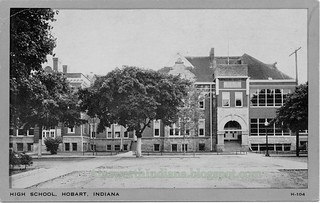Regarding Walton's Mill, Solon Robinson gives us only the surname and the general location, "on Turkey Creek." Turning to Early Land Sales, Lake County, we find a Charles Walton, in 1840, purchasing the east half of the southwest quarter of Section 2, Township 35 N., Range 8 W.:

(Click on image to enlarge)
Screenshot from Google Maps.
As you can see, this parcel of land lies over Turkey Creek, and on its eastern side, Liverpool Road — a main-travelled road in those days — provided a way for customers to reach a commercial venture like a mill.[1]
I believe we have already met this Charles Walton before in this blog: in 1838, when he appraised part of Jeremiah Wiggins' estate, and in 1839, when he came to a Hobart-area store to buy opium and then a coffin for his brother. So he was already in this area before 1840. In fact, Porter and Lake Counties (Goodspeed/Blanchard) tells us that Charles Walton arrived in Ross Township in 1837 [p. 544], and continues: "In 1837 or 1838, a good saw-mill was built three miles northeast of Merrillville by Charles Walton" [p. 551]. That description of the mill's location fits the Liverpool Road/Turkey Creek area.
Goodspeed/Blanchard goes on to say that Charles Walton "sold to Louverman,[2] who ran [the mill] until 1848" [p. 551]. Returning to Solon Robinson's history up to 1847, we find this comment:
There are five saw mills in operation in the county, to-wit: Earle's, Dustin's and Wood's on Deep River; McCarty's on Cedar Creek and Foley's on a branch of Cedar Creek. (There are three dilapidated ones, to-wit: Miller's and Dustin's old mills on Deep River, and Walton's on Turkey Creek, the last about being repaired.)[3]If the mill was dilapidated and undergoing repairs in 1847, and the mysterious Louverman stopped operating it in 1848, it must have had a short working life in the 1840s.
I have found a few more related references in the early daybooks at the Hobart Historical Society museum that I have indexed thus far. Most of them appear below.
The earliest, from November 1836, may not refer to our Charles, but I find it interesting:

(Click on image to enlarge)
Image courtesy of the Hobart Historical Society.
The way the storekeeper wrote that entry seems to say: "I didn't catch his first name, but I know he's a miller." (He could not have been from the town of Miller because it didn't exist in 1836.)
The first clear reference to Charles doesn't come until the summer of 1839. He is all over these two pages, selling cut lumber to the store, and receiving $6.00 in cash:

(Click on image to enlarge)
Image courtesy of the Hobart Historical Society.
This water-damaged page of the same daybook shows Charles, in the winter of 1840, selling lumber to the store, and buying a saw:

(Click on image to enlarge)
Image courtesy of the Hobart Historical Society.
The first entry under his name reads: "55 ft of lumber hauled by Watkins and left on causeway of ferry." I suppose that was the ferry over the Deep River at Liverpool, about 3.5 miles from Charles' mill up the Liverpool Road.
Here's a non-lumber transaction from May of 1840: Charles purchases some household items (including a "rummer" — a drinking glass) and pays part of their price with 10 and a half pounds of butter and a raccoon skin.

(Click on image to enlarge)
Image courtesy of the Hobart Historical Society.
In July of 1840, Charles comes in and buys half a gallon of whiskey.

(Click on image to enlarge)
Image courtesy of the Hobart Historical Society.
That same summer (exact date unclear but seems to be in August), Charles furnished lumber for the building of a boat:

(Click on image to enlarge)
Image courtesy of the Hobart Historical Society.
Beyond the summer of 1840, I have not found any transactions involving him. The three account books from which I have taken these images go up to 1837, 1846, and 1849, respectively. That boat-lumber may have been Charles' swan song on Turkey Creek, or at least one of its verses. Even if the Waltons remained on the land for some time yet, the mill probably was abandoned soon after 1840: I would expect that several years' neglect were needed for it to become "dilapidated," as Solon Robinson described it, by 1847.
As I mentioned in one of those earlier posts about Charles, I have not been able to find any census or other official information about him outside of the 1840 Census, where he and his household appear:[4]

(Click on image to enlarge)
Image from Ancestry.com.
Between 40 and 49 years of age, one male and one female — Charles and his wife, I suppose. That would put their birthdates at about 1795, give or take five years. All the other household members are children under 15 years of age, two boys and three girls. Without names for the wife and children, it's pretty much impossible to determine if any one of the Charles Waltons who turn up when you search on that name and that approximate birth year is our Charles.
As for his brother, whose name is unknown except that it started with S — it's possible that when he died in 1839, he was simply buried on the family's land. To this day, perhaps, his body is still resting somewhere near the spot where Liverpool Road crosses Turkey Creek.
[To be continued …]
_______________
[1] Early Land Sales, Lake County includes a few other purchases by people with the surname Walton (different first names), but none of them bought land on Turkey Creek.
[2] I have failed to turn up any records at all of this Louverman.
[3] "History of Lake County, 1833 – 1847," Lake County 1929, p. 59.
[4] Notice the neighbors listed near him: a who's-who of early Hobart and Merrillville settlers.











